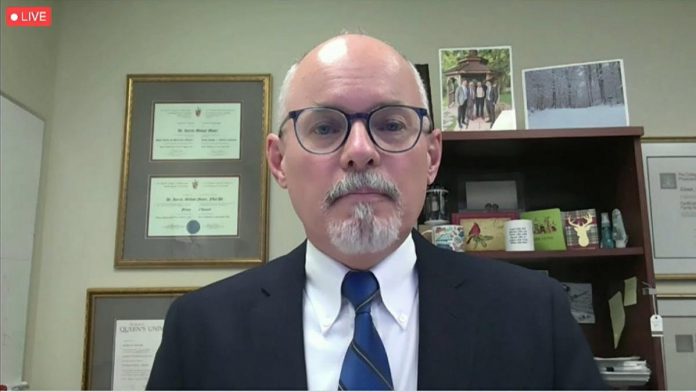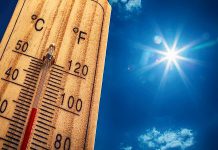
On the same day Ontario reported a pandemic high of new COVID-19 cases due to the highly transmissible omicron variant, the provincial government announced a series of changes to public health measures and guidance.
The changes include limiting eligibility for PCR tests to high-risk people, reducing the isolation period for fully vaccinated people, reserving rapid antigen tests for health care and the highest-risk settings, restricting spectator capacity to 50 per cent of capacity or 1,000 people (whichever is less) indoors at sports venues, concert venues, and theatres, offering fourth doses to long-term care residents, mandating third doses for all long-term care staff, students, volunteers, caregivers, and support workers, and delaying the return to school by two days.
“Today we are reporting 13,807 new cases of COVID-19 in Ontario,” said Dr. Kieran Moore, Ontario’s chief medical officer of health, during a virtual media conference on Thursday (December 30). “I know that this number and the numbers that we have seen in the last few days feel overwhelmingly high but, with a doubling time of approximately three days, we must be prepared to see our cases continue to grow.”
“The good news is that with this increase of cases, we have not seen a corresponding rapid increase in hospitalizations and ICU admissions. Today we are reporting 965 people in hospital, and 200 people in ICU due to COVID-related critical illness.”
Dr. Moore added that, while omicron is clearly more transmissible, preliminary findings from Public Health Ontario suggest it is less virulent than earlier strains of the virus.
“The risk of hospitalization or death was 54 per cent lower for omicron cases as compared to delta cases,” he said, cautioning that the number of hospitalizations and impacts on the health care sector will still be “significant” due to the variant’s high transmissibility.
Dr. Moore said the province has asked hospitals to update their daily reporting to distinguish the number of people admitted to hospital or ICUs for COVID-19 from those who are admitted for other reasons, “such as a broken bone or appendicitis,” but who also test positive for COVID-19.
Effective Friday (December 31), publicly funded PCR testing will only be available for high-risk people who are symptomatic or who are at risk of severe illness from COVID-19 — including for the purposes of confirming a COVID-19 diagnosis to begin treatment — and workers and residents in the highest-risk settings as well as vulnerable populations. Eligible groups for PCR testing are outlined at news.ontario.ca/en/backgrounder/1001387/updated-eligibility-for-pcr-testing-and-case-and-contact-management-guidance-in-ontario.
This change means the government is asking members of the general public with mild symptoms of COVID-19 to no longer seek PCR testing. There will also be no PCR tests for asymptomatic people in the community. The government is also no longer requiring or encouraging most people with a positive result from a rapid antigen test to get a confirmatory PCR or rapid molecular test.
“This we recognize reflects some significant changes from our previous COVID testing strategy, which meant that anyone with symptoms could receive a PCR test,” Dr. Moore said. “But the omicron variant is rapidly spreading, and we must preserve these resources for those who need them the most.”
Dr. Moore said the government has a limited supply of rapid antigen tests and is prioritizing the tests for health care and highest risk settings. This includes rapid antigen test use for “test-to-work” situations where asymptomatic staff in these sectors can return to work when they would otherwise be on isolation at home. Rapid antigen testing may be used to confirm if a symptomatic person has COVID-19, with no requirement for a confirmatory PCR or rapid molecular test.
“This means that, if you have symptoms of COVID-19 and are not eligible for a PCR test and do not have access to a rapid antigen test, you should assume that you have COVID-19 and isolate according to our revised guidelines.”
Ontario is also changing the required isolation period for people with COVID-19 who are vaccinated and children under 12 — as well as their household contacts — to five days following the onset of symptoms. If their symptoms are improved for at least 24 hours after five days, they can end isolation as long as they continue to follow all public health and safety measures including masking and physical distancing. Non-household contacts of these people are not required to isolate, but must self-monitor for symptoms for 10 days.
People with COVID-19 who are unvaccinated, partially vaccinated, or immunocompromised will be required to isolate for 10 days.
While the government recommends that those who work or live in high-risk health care settings return to work after 10 days from their last exposure or symptom onset or from their date of diagnosis, to ensure sufficient staffing levels in health care settings, they have the option to return to work after isolating for seven days, based on a negative PCR on day six or two negative rapid antigen tests on day six and seven. The province will provide the testing through the health-care setting.
When it comes to case and contact management, Dr. Moore said that public health will “shift its focus” to positive cases in high-risk settings such as long-term care homes and retirement homes.
“Other individual cases will be asked to identify and inform their own close contacts,” Dr. Moore said. “This means that not everyone will get a call from public health with guidance or next steps.”
Dr. Moore said lower-risk individuals with COVID-19 symptoms who think or known they may have been exposed should visit ontario.ca/exposed for more information.
Effective immediately, the province will be making fourth doses of mRNA vaccines available to residents of long-term care homes, retirement homes, Elder Care Lodges, and other congregate care settings if at least three months, or 84 days, have passed since their third dose.
By January 28, all staff, students, volunteers, caregivers, and support workers in long-term care homes will be required to get a third dose of a COVID-19 vaccine if they are eligible for one. All visitors to long-term care homes will be required to provide proof of a booster dose once the temporary pause on general visitors is lifted.
Effective at 12:01 a.m. on Friday (December 31), Ontario is restricting spectator capacity to 50 per cent of the usual seating capacity or 1,000 people (whichever is less) in the indoor areas of
spectator areas of facilities used for sports and recreational fitness activities (e.g., sporting events), concert venues, and theatres. Previously, the capacity limit on these settings was 50 per cent regardless of the maximum capacity of the venue.
“Finally, I know many parents and students are anxious to hear about the return to school,” Dr. Moore said. “I and colleagues from across Ontario have always maintained that schools should be the last to close and the first to open. It is critical to the positive mental health and academic success of our children.”
Dr. Moore confirmed students will return to in-person learning on Wednesday (January 5), two days later than originally scheduled.
“This will provide our schools with extra time to begin to put in place additional health and safety measures,” Dr. Moore said, which include:
- More rigorous screening and monitoring of symptoms for students, parents, and staff.
- Providing non-fit-tested N95 masks for staff in schools and licensed child care settings as an optional alternative to medical or surgical masks, and additional supply of free high-quality three-ply cloth masks for students and children in January.
- Providing an additional 3,000 standalone HEPA filter units to school boards.
- Continuing PCR testing eligibility for symptomatic elementary and secondary students, education staff, and participating private and First Nation operated schools who have received a PCR self-collection kit through their school.
- Temporarily permitting only low-contact indoor sports and safe extra-curricular activities starting in January.
- Updating COVID-19 reporting requirements for school boards and child care in January.
- Supporting the projected hiring of over 2,000 staff, including additional teachers, custodians, and mental health workers.
“I understand that we’re all tired and just want this pandemic to be over,” Dr. Moore said. “Unfortunately though, we need to get through this omicron wave.”
“I’m hopeful that, with the effort that we are putting in now, 2022 will prove to be a year that we are able to get the better of this virus.”


























